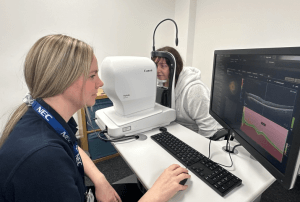Optical Coherence Tomography (OCT) Scans

What is OCT?
OCT uses light waves to take more than 1,000 images of your eye, from the retina to the optic nerve, to create a detailed 3D image that gives more accurate results than standard cameras. The scans detect changes to the eye that don’t show up in colour photography, such as a thickening of the retina.
Why is it being launched?
It is estimated that 120,000 hospital ophthalmology appointments are set to be saved through OCT, once rolled out across the country, helping ease hospital backlogs and it is expected the number of hospital appointments saved will continue to rise.
Who will receive OCT scans?
The following service users will receive OCT scans:
– Service users in Digital Surveillance (DS) pathway (except pregnant patients) who are screened more frequently.
– Service users whose last results show signs diabetic retinopathy progression (i.e. R2L, R3S or low risk M1)
– Maculopathy monitoring referrals back from the Hospital Eye Services.
What does this mean to me?
If you are eligible for OCT scans, your local Diabetic Eye Screening Programme (DESP) will send you an appointment letter when your next screening appointment is nearly due. It’s important to attend the appointment to prevent the development of diabetic retinopathy. However, the implementation of OCT scans may vary from different local DESPs. Please check with your local DESP for the exact rollout date.
About Diabetic Eye Screening Programme (DESP)
Around four million people are currently registered with the NHS DESP, and 3.3 million have routine digital screening every one or two years. It is expected around 60,000 people who are already showing signs of eye disease will take part in OCT scans, which is offered to people at higher risk of diabetic retinopathy.
Our OCT screening venues:
– BANES, Swindon & Wiltshire
1. Swindon Health Centre (Swindon)
2. Salisbury Medical Practice (Wiltshire)
3. Riverside Health Centre (Bath)
– Central Merseyside
1. The Outset (Warrington)
2. ASDA St. Helens (St. Helens)
3. Millbrow Clinic (Halton)
4. Manor Farm Primary Care Resource Centre (Knowsley)
– Dorset
1. Bournemouth Life Centre (Bournemouth)
2. The Spire (Poole)
3. St Aldhelms Church (Weymouth)
– South West London
1. Purley War Memorial Hospital
2. Junction Health Centre
3. The Nelson Health Centre
For more information, please visit NHS England website:
OCT Eye Scans FAQs
The expected rollout date is April 2025. Appointment letters will be sent out in due course.
The nation-wide OCT rollout means around 60,000 people with diabetes can receive advanced screening outside a traditional hospital setting, freeing up hospital care for people who need it most.
We highly recommend you attend this appointment – we have seen indications of more advanced diabetes-related changes, so it is vital we analyse and monitor these more frequently to avoid progression.
If you cannot make your screening appointment, let us know as soon as possible. We may be able to offer your appointment to someone else. You can call us to change the time, date and venue of your appointment.
Dilation drops are used to make the pupils as wide as possible to ensure we get the clearest view we can of the back of the eye. The stinging wears off quickly, and for most the blurred vision returns to normal after a few hours.
OCT is a specialist piece of equipment that cannot be moved. We apologise if we have to ask you to travel farther than normal to have this more in-depth screening. We aim to get more OCT at other locations in the future to improve the service.
The OCT scanning is still a part of diabetes care, and is free for any service users with diabetes and over 12.
No, you can continue to have screening at your usual screening service. If we find something of concern, you will be sent to your local hospital eye service for review.
The OCT service is available to those who need to be closely monitored, for instance:
– Service users in Digital Surveillance (DS) pathway (except pregnant patients) who are screened more frequently.
– Service users whose last results show signs diabetic retinopathy progression (i.e. R2L, R3S or low risk M1)
– Maculopathy monitoring referrals back from the Hospital Eye Services.
